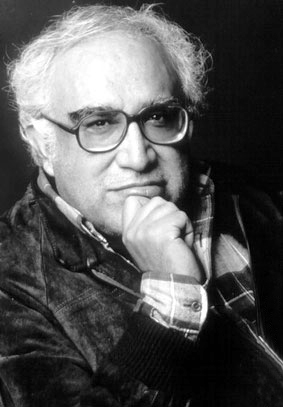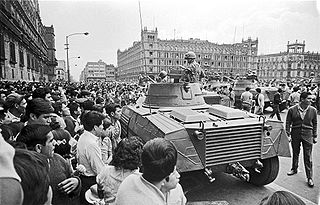The 1968 Summer Olympics, officially known as the Games of the XIX Olympiad and commonly known as Mexico 1968, were an international multi-sport event held from 12 to 27 October 1968 in Mexico City, Mexico. These were the first Olympic Games to be staged in Latin America and the first to be staged in a Spanish-speaking country. They were also the first Games to use an all-weather (smooth) track for track and field events instead of the traditional cinder track, as well as the first example of the Olympics exclusively using electronic timekeeping equipment.

The Tlatelolco massacre was a military massacre committed against the students of the National Autonomous University of Mexico (UNAM), the National Polytechnic Institute (IPN), and other universities in Mexico.

Beginning in May 1968, a period of civil unrest occurred throughout France, lasting seven weeks and punctuated by demonstrations, general strikes, and the occupation of universities and factories. At the height of events, which have since become known as May 68, the economy of France came to a halt. The protests reached a point that made political leaders fear civil war or revolution; the national government briefly ceased to function after President Charles de Gaulle secretly fled France to West Germany on the 29th. The protests are sometimes linked to similar movements around the same time worldwide that inspired a generation of protest art in the form of songs, imaginative graffiti, posters, and slogans.

The Puerto Rican Socialist Party was a Marxist and pro-independence political party in Puerto Rico seeking the end of United States of America control on the Hispanic and Caribbean island of Puerto Rico. It proposed a "democratic workers' republic".

The Mexico City Metro is a rapid transit system that serves the metropolitan area of Mexico City, including some municipalities in the State of Mexico. Operated by the Sistema de Transporte Colectivo (STC), it is the second largest metro system in North America after the New York City Subway.

Muhammad Sidi Brahim Sidi Embarek Basir was a Sahrawi nationalist leader, disappeared and presumedly executed by the Spanish Legion in June 1970.

Carlos Monsiváis Aceves was a Mexican philosopher, writer, critic, political activist, and journalist. He also wrote political opinion columns in leading newspapers within the country's progressive sectors. His generation of writers includes Elena Poniatowska, José Emilio Pacheco, and Carlos Fuentes. Monsiváis won more than 33 awards, including the 1986 Jorge Cuesta Prize, the 1989 Mazatlán Prize, and the 1996 Xavier Villaurrutia Award. Considered a leading intellectual of his time, Monsiváis documented contemporary Mexican themes, values, class struggles, and societal change in his essays, books and opinion pieces. He was a staunch critic of the long-ruling Partido Revolucionario Institucional (PRI), leaned towards the left-wing, and was ubiquitous in disseminating his views on radio and television. As a founding member of "Gatos Olvidados", Monsiváis wanted his and other "forgotten cats" to be provided for beyond his lifetime.

The protests of 1968 comprised a worldwide escalation of social conflicts, which were predominantly characterized by the rise of left-wing politics, anti-war sentiment, civil rights urgency, youth counterculture within the silent and baby boomer generations, and popular rebellions against state militaries and bureaucracies.

The Spanish expression la Raza has historically been used to refer to the mixed-race populations, considered as an ethnic or racial unit historically deriving from the Spanish Empire, and the process of racial intermixing during the Spanish colonization of the Americas with the indigenous populations of the Americas.
La Onda was a multidisciplinary artistic movement created in Mexico by artists and intellectuals as part of the worldwide waves of the counterculture of the 1960s and the avant-garde. Pejoratively called as Literatura de la Onda by Margo Glantz in the beginning, the movement quickly grew and included other art forms with its followers called "onderos", "macizos" or "jipitecas". La Onda encompassed artistic productions in the worlds of cinema, literature, visual arts and music and strongly addressed social issues of the time such as women's rights, ecology, spirituality, artistic freedom, open drug use and democracy in a country tightly ruled by the PRI. According to Mexican intellectual Carlos Monsiváis, La Onda was "a new spirit, the repudiation of convention and prejudice, the creation of a new morality, the challenging of proper morals, the expansion of consciousness, the systematic revision and critique of the values offered by the West as sacred and perfect."

The Mexican Movement of 1968, also known as the Mexican Student Movement was a social movement composed of a broad coalition of students from Mexico's leading universities that garnered widespread public support for political change in Mexico. A major factor in its emergence publicly was the Mexican government's lavish spending to build Olympic facilities for the 1968 Olympics in Mexico City. The movement demanded greater political freedoms and an end to the authoritarianism of the PRI regime, which had been in power since 1929.

The Dance of the Forty-One or the Ball of the Forty-One was a society scandal in early 20th-century Mexico, during the presidency of Porfirio Díaz. The incident revolved around an illegal police raid carried out on 17 November 1901 against a private home on Calle de la Paz in Colonia Tabacalera of Mexico City, the site of a dance attended by a group of men, of whom 19 were dressed in women's clothing.
Cradle Song is a 1953 Mexican film. It was directed by Fernando de Fuentes.

Hector Garcia Cobo was a Mexican photographer and photojournalist who had a sixty-year career chronicling Mexico's social classes, Mexico City and various events of the 20th century, such as the 1968 student uprising. He was born poor but discovered photography in his teens and early 20s, deciding to study it seriously after his attempt to photograph the death of a coworker failed. He was sent to the Academia Mexicana de Artes y Ciencias Cinematográficas by magazine director Edmundo Valdés who recognized García's talent. Most of García's career was related to photojournalism, working with publications both inside and outside of Mexico. However, a substantial amount of his work had more artistic and critical qualities. Many of these were exhibited in galleries and museums, with sixty five individual exhibitions during his lifetime. This not only included portraits of artists and intellectuals but also portraits of common and poor people. He was also the first photojournalist to explicitly criticize Mexico's elite, either making fun of them or contrasting them to the very poor.
The Casa del Obrero Mundial or COM was a libertarian socialist and anarcho-syndicalist worker's organization located in the popular Tepito Barrio of Mexico City, founded on September 22, 1912. One of its founders was Antonio Díaz Soto y Gama, one of the founders of the Liberal Party of Mexico (PLM) and later a secretary in Emiliano Zapata's army. COM served as a cultural institution promoting worker's education and social transformation through a rationalist, socialist orientation, and as the headquarters for a number of syndicates and unions on a mutual aid basis.
Leobardo López Aretche was a Mexican film director.

The National Strike Council, the Consejo Nacional de Huelga (CNH) was created on August 2, 1968, composed of the National Autonomous University of Mexico (UNAM), the National Polytechnic Institute (IPN), El Colegio de Mexico, the School of Agriculture of Chapingo, the Universidad Iberoamericana, the Universidad La Salle and other universities in Mexico.
Unomásuno is a Mexican daily tabloid newspaper circulated in Mexico City. Formed in 1977 by former employees of Mexico City's daily newspaper Excélsior, it became one of the leading leftist newspapers in Mexico during the late 1970s and early 1980s. The newspaper covered investigative topics that were often avoided by the rest of the Mexican press at the time, and it was a harsh critic of the Mexican government. By the mid-1980s, disagreements over the newspaper's management style led to internal divisions. Those who disagreed with Unomásuno and its future initiatives left in 1984 and formed La Jornada, another leftist daily in Mexico City.
Anarchism in Guatemala emerged from the country's labor movement in the late 19th century. Anarcho-syndicalism rose to prominence in the early 20th century, reaching its peak during the 1920s, before being suppressed by the right-wing dictatorship of Jorge Ubico.
The Frente de Liberación Homosexual, was the first public organization for gay liberation in Mexico. It was led and cofounded by lesbian activist Nancy Cárdenas in 1971.











